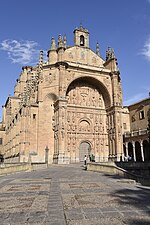Café Novelty

The Café Novelty (Coffeehouse Novelty) is the oldest café in the city of Salamanca (Spain), which was founded in 1905 and is situated in the main square of the city, Plaza Mayor de Salamanca. Its first owners were the García brothers. From the beginning of the Spanish Civil War to 1964 it was named Café Nacional. It was 4 times bigger than it is nowadays and it very soon became a favorite meeting place for writers, artists and politicians, due to its privileged position in the city.The most outstanding patrons of the Café Novelty are Miguel de Unamuno, the Spanish philosopher that organized the literary social gathering (tertulia), Ortega y Gasset, Antonio Tovar, Juan Benet, Pedro Laín Entralgo, Francisco Umbral, Carmen Martín Gaite, Gonzalo Torrente Ballester and Víctor García de la Concha. At its tables, in 1923, Dionisio Ridruejo decided to found the Football Club of Salamanca, and also the Spanish National Radio, between 1936 and 1937.From 1999, with the help of the members of the cultural society of Salamanca, a magazine of the café, "Los papeles del Novelty", has been published.
Excerpt from the Wikipedia article Café Novelty (License: CC BY-SA 3.0, Authors, Images).Café Novelty
Calle Toro, Salamanca
Geographical coordinates (GPS) Address Nearby Places Show on map
Geographical coordinates (GPS)
| Latitude | Longitude |
|---|---|
| N 40.965341666667 ° | E -5.6636361111111 ° |
Address
Ayuntamiento de Salamanca
Calle Toro
37002 Salamanca (Centro)
Castile and León, Spain
Open on Google Maps









